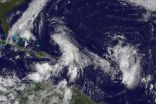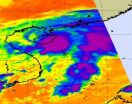A thirst for excitement is hidden in your genes
2010-10-06
(Press-News.org) Sensation seeking—the urge to do exciting things—has been linked to dopamine, a chemical that carries messages in your brain. For a new study published in Psychological Science, a journal of the Association for Psychological Science, scientists analyzed genes in the dopamine system and found a group of mutations that help predict whether someone is inclined toward sensation seeking.
Sensation seeking has been linked to a range of behavior disorders, such as drug addiction. It isn't all bad, though. "Not everyone who's high on sensation seeking becomes a drug addict. They may become an Army Ranger or an artist. It's all in how you channel it," says Jaime Derringer, a PhD student at the University of Minnesota and the first author of the study. She wanted to use a new technique to find out more about the genetics of sensation seeking. Most obvious connections with genes, like the BRCA gene that increases the risk for breast cancer, have already been found, Derringer says. Now new methods are letting scientists look for more subtle associations between genes and all kinds of traits, including behavior and personality.
Derringer used a kind of mutation in DNA called a single-nucleotide polymorphism, or SNP. A SNP is a change in just one "letter" of the DNA. She started by picking eight genes with various roles related to the neurotransmitter dopamine, which has been linked to sensation seeking in other studies. She looked at group of 635 people who were part of a study on addiction. For each one, she had genetic information on 273 SNPs known to appear in those 8 genes and a score for how much they were inclined to sensation seeking. Using that data, she was able to narrow down the 273 SNPs to 12 potentially important ones. When she combined these 12 SNPs, they explained just under 4 percent of the difference between people in sensation seeking. This may not seem like a lot, but it's "quite large for a genetic study," Derringer says.
It's too soon to go out and start screening people for these mutations; not enough is known about how genes affect behavior. "One of the things we think is most exciting about this isn't necessarily the story about dopamine and sensation seeking," says Derringer. "It's rather the method that we're using. We used a sample of 635 people, which is extremely small, and we were still able to detect a significant effect. That's actually quite rare in these studies." She said the same method could be used to look at the link between biology and other behaviors—dopamine and cocaine dependence, for example, or serotonin and depression.
Eventually these methods could lead to tests that might help predict whether someone is likely to have problems later, and whether there should be early intervention to guide them down a healthier path.
###
For more information about this study, please contact Jaime Derringer at derri023@umn.edu.
The APS journal Psychological Science is the highest ranked empirical journal in psychology. For a copy of the article "Predicting Sensation Seeking From Dopamine Genes: A Candidate-System Approach" and access to other Psychological Science research findings, please contact Keri Chiodo at 202-293-9300 or kchiodo@psychologicalscience.org.
END
ELSE PRESS RELEASES FROM THIS DATE:
2010-10-06
DURHAM, N.H. -- Looking at a hagfish – an eyeless, snot-covered, worm-like scavenger of the deep –the last thing that comes to mind is sex. Yet the reproductive functioning of these ancient vertebrates is such an enduring enigma that a gold medal was once offered to anyone who could elucidate it.
Although the prize expired, unclaimed, long ago, University of New Hampshire professor of biochemistry Stacia Sower and colleagues at two Japanese universities have identified the first reproductive hormone of the hagfish – a gonadatropin -- representing a significant step toward ...
2010-10-06
Researchers from Northwestern University and NorthShore University HealthSystem (NorthShore) have developed a method to detect early signs of lung cancer by examining cheek cells in humans using pioneering biophotonics technology.
"By examining the lining of the cheek with this optical technology, we have the potential to prescreen patients at high risk for lung cancer, such as those who smoke, and identify the individuals who would likely benefit from more invasive and expensive tests versus those who don't need additional tests," said Hemant K. Roy, M.D., director ...
2010-10-06
Berkeley – Exposure to dirty air is linked to decreased function of a gene that appears to increase the severity of asthma in children, according to a joint study by researchers at Stanford University and the University of California, Berkeley.
While air pollution is known to be a source of immediate inflammation, this new study provides one of the first pieces of direct evidence that explains how some ambient air pollutants could have long-term effects.
The findings, published in the October 2010 issue of the Journal of Allergy and Clinical Immunology, come from ...
2010-10-06
WEST LAFAYETTE, Ind. - Doppler weather radar will significantly improve forecasting models used to track monsoon systems influencing the monsoon in and around India, according to a research collaboration including Purdue University, the National Center for Atmospheric Research and the Indian Institute of Technology Delhi.
Dev Niyogi, a Purdue associate professor of agronomy and earth and atmospheric sciences, said modeling of a monsoon depression track can have a margin of error of about 200 kilometers for landfall, which can be significant for storms that produce as ...
2010-10-06
The GOES-13 satellite passed over a low pressure area designated as "System 97L" earlier today and captured a visible image of the low in the eastern Caribbean Sea. System 97L appears in a good place for development into a tropical depression in the next day or two.
The National Hurricane Center currently gives the low pressure area known as System 97L an "80 percent chance of developing into a tropical depression in the next 48 hours." The low pressure area is located just north of the Virgin Islands near 19.0 North latitude and 65.3 West longitude. The visible image ...
2010-10-06
The northwestern Pacific Ocean is just as active as the Atlantic Ocean this hurricane season. The fourteenth tropical depression formed near Hainan Island, China this morning and its birth was captured by a NASA infrared satellite instrument. The NASA image showed the depression's strong thunderstorms near its center and east of its center.
NASA's Aqua satellite flew over Tropical Depression 14W (TD14W) today, October 5 at 06:05 UTC (2:05 a.m. EDT). Infrared imagery from the Atmospheric Infrared Sounder (AIRS) instrument onboard the Aqua satellite revealed a concentrated ...
2010-10-06
A new species of dinosaur discovered in Arizona suggests dinosaurs did not spread throughout the world by overpowering other species, but by taking advantage of a natural catastrophe that wiped out their competitors.
The new dinosaur, named Sarahsaurus, was studied by an international team of scientists, including Robert R. Reisz, professor and chair of biology at the University of Toronto Mississauga, Tim Rowe, professor of paleontology at the University of Texas at Austin's Jackson School of Geosciences and Hans-Dieter Sues, curator of vertebrate paleontology at the ...
2010-10-06
The Red Planet bleeds. Not blood, but its atmosphere, slowly trickling away to space. The culprit is our sun, which is using its own breath, the solar wind, and its radiation to rob Mars of its air. The crime may have condemned the planet's surface, once apparently promising for life, to a cold and sterile existence.
Features on Mars resembling dry riverbeds, and the discovery of minerals that form in the presence of water, indicate that Mars once had a thicker atmosphere and was warm enough for liquid water to flow on the surface. However, somehow that thick atmosphere ...
2010-10-06
GREENBELT, Md. – NASA's mission to investigate the mystery of how Mars lost much of its atmosphere passed a critical milestone on October 4, 2010. NASA has given approval for the development and 2013 launch of the Mars Atmosphere and Volatile Evolution (MAVEN) mission.
Clues on the Martian surface, such as features resembling dry riverbeds and minerals that only form in the presence of liquid water, suggest that Mars once had a denser atmosphere, which supported the presence of liquid water on the surface. As part of a dramatic climate change, most of the Martian atmosphere ...
2010-10-06
With the Major League Baseball Division Series set to begin, associate math professor Bruce Bukiet at NJIT is performing his analysis of the probability of each team advancing to the League Championship Series. "Going into these series, the Philadelphia Phillies have a 64 percent chance of defeating the Cincinnati Reds in their best of five game series," he said.
"The Texas Rangers, New York Yankees and San Francisco Giants have slight advantages to win series over their opponents, the Tampa Bay Rays, Minnesota Twins and Atlanta Braves respectively in the first round ...
LAST 30 PRESS RELEASES:
[Press-News.org] A thirst for excitement is hidden in your genes



